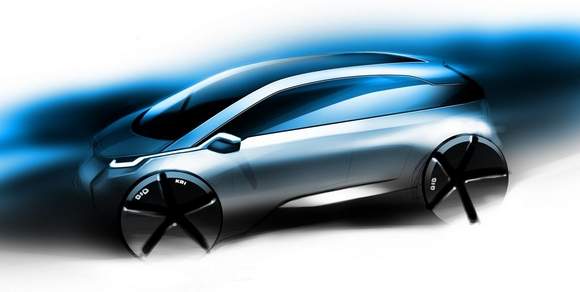BMW MegaCity EV Hides Much Bigger Find: Affordable Carbon Fiber

When word of the BMW EV called „MegaCity“ first made the rounds, our Ed Niedermeyer called it “BMW’s long-rumored Neo-Isetta EV.” Now, BMW opened the first button of their electric blouse.
At a presentation in the BMW museum, BMW showed first MegaCity drawings. The sketches were shown by BMWs chief designer Adrian van Hooydonk, and by Benoit Jacobs, who’s the designer-in-charge for the project. Here is what Automobilwoche [sub] took away from the meeting:
- The car will be built from carbon fiber, 50 percent lighter than steel, 30 percent lighter than aluminum. BMW has developed a process that makes carbon fiber much less expensive than before.
- The carbon fiber is 100 percent recyclable and needs no painting.
- This makes the car 100kg lighter, which compensates for the battery, which would make the car 100kg heavier.
- The car will be launched 2013 under a BMW sub-brand
Affordable carbon fiber, something that is being worked on in Germany and in Japan, could be even more important for the future of the EV than battery technology. That battery is heavy, and ever since Newton made force, mass, and acceleration inseparable, weight loss has been the key to power and range. That carbon fiber story might be much more interesting than the drawings. The real car never looks like the drawing anyway.
According to The Nikke i [sub], Japan’s “Toray is seeking to develop carbon fiber products for use in high-end vehicles in collaboration with Daimler AG by 2012. Mitsubishi Rayon is teaming up with German materials group SGL to make materials used in a BMW AG electric car due out in 2015. A limited-edition Toyota sports car slated to hit the market at year-end will use Toho Tenax’s material. The Teijin subsidiary has approached several carmakers with a prototype vehicle whose carbon fiber composite use makes it 60% lighter.”
The Teijin process sounds most interesting. Teijin can process the material in just one minute. Their material is 10 times stronger and 75 percent lighter than comparable metals, says the company.

Bertel Schmitt comes back to journalism after taking a 35 year break in advertising and marketing. He ran and owned advertising agencies in Duesseldorf, Germany, and New York City. Volkswagen A.G. was Bertel's most important corporate account. Schmitt's advertising and marketing career touched many corners of the industry with a special focus on automotive products and services. Since 2004, he lives in Japan and China with his wife <a href="http://www.tomokoandbertel.com"> Tomoko </a>. Bertel Schmitt is a founding board member of the <a href="http://www.offshoresuperseries.com"> Offshore Super Series </a>, an American offshore powerboat racing organization. He is co-owner of the racing team Typhoon.
More by Bertel Schmitt
Latest Car Reviews
Read moreLatest Product Reviews
Read moreRecent Comments
- Jkross22 Their bet to just buy an existing platform from GM rather than build it from the ground up seems like a smart move. Building an infrastructure for EVs at this point doesn't seem like a wise choice. Perhaps they'll slow walk the development hoping that the tides change over the next 5 years. They'll probably need a longer time horizon than that.
- Lou_BC Hard pass
- TheEndlessEnigma These cars were bought and hooned. This is a bomb waiting to go off in an owner's driveway.
- Kwik_Shift_Pro4X Thankfully I don't have to deal with GDI issues in my Frontier. These cleaners should do well for me if I win.
- Theflyersfan Serious answer time...Honda used to stand for excellence in auto engineering. Their first main claim to fame was the CVCC (we don't need a catalytic converter!) engine and it sent from there. Their suspensions, their VTEC engines, slick manual transmissions, even a stowing minivan seat, all theirs. But I think they've been coasting a bit lately. Yes, the Civic Type-R has a powerful small engine, but the Honda of old would have found a way to get more revs out of it and make it feel like an i-VTEC engine of old instead of any old turbo engine that can be found in a multitude of performance small cars. Their 1.5L turbo-4...well...have they ever figured out the oil dilution problems? Very un-Honda-like. Paint issues that still linger. Cheaper feeling interior trim. All things that fly in the face of what Honda once was. The only thing that they seem to have kept have been the sales staff that treat you with utter contempt for daring to walk into their inner sanctum and wanting a deal on something that isn't a bare-bones CR-V. So Honda, beat the rest of your Japanese and Korean rivals, and plug-in hybridize everything. If you want a relatively (in an engineering way) easy way to get ahead of the curve, raise the CAFE score, and have a major point to advertise, and be able to sell to those who can't plug in easily, sell them on something that will get, for example, 35% better mileage, plug in when you get a chance, and drives like a Honda. Bring back some of the engineering skills that Honda once stood for. And then start introducing a portfolio of EVs once people are more comfortable with the idea of plugging in. People seeing that they can easily use an EV for their daily errands with the gas engine never starting will eventually sell them on a future EV because that range anxiety will be lessened. The all EV leap is still a bridge too far, especially as recent sales numbers have shown. Baby steps. That's how you win people over.


































Comments
Join the conversation
Maybe they will be able to get the 3 down to 2400 lbs.
I'm waaaay more interested in cheap CF than I'll ever be in battery-powered transportation appliances.